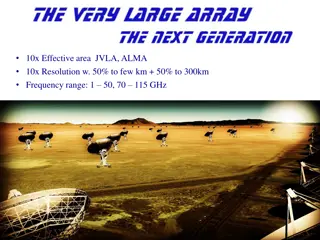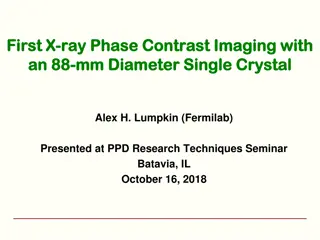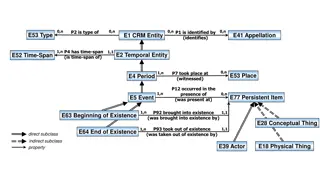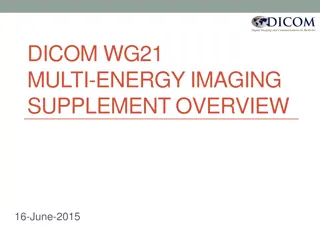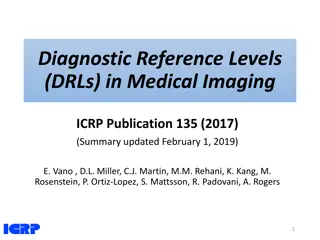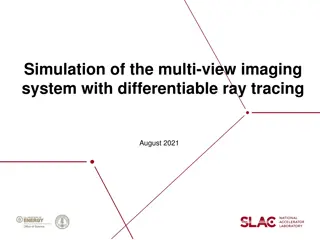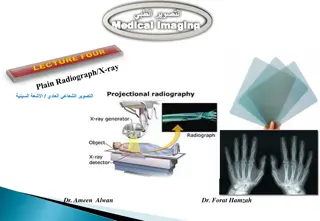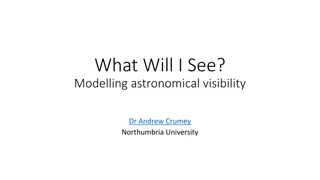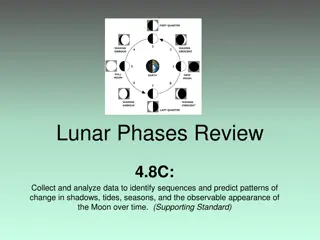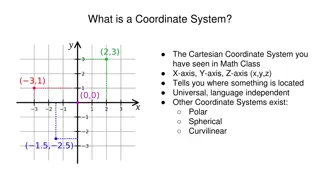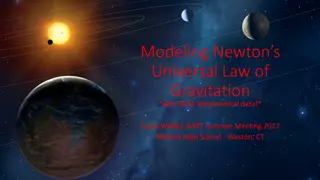Understanding Spatial Resolution in Astronomical Imaging
This lecture delves into the requirements for resolution and sensitivity in astronomical imaging, exploring factors such as spatial resolution, optical design aberrations, and noise sources. It explains how spatial resolution is crucial in distinguishing objects, discussing the Rayleigh criterion and factors that can limit resolution, such as diffraction and atmospheric turbulence. The lecture also covers image formation processes, Airy patterns, and the Rayleigh criterion for telescopic resolutions.
Download Presentation

Please find below an Image/Link to download the presentation.
The content on the website is provided AS IS for your information and personal use only. It may not be sold, licensed, or shared on other websites without obtaining consent from the author. Download presentation by click this link. If you encounter any issues during the download, it is possible that the publisher has removed the file from their server.
E N D
Presentation Transcript
UNIVERSITY ASTRONOMY Professor Don Figer Imaging 1
Aims and outline for this lecture derive resolution and sensitivity requirements for astronomical imaging spatial resolution optical design abberations sensitivity review noise shot noise from signal shot noise from background detector noise
Spatial Resolution Spatial resolution is the minimum distance between two objects that can be distinguished with an imaging system. Note that the definition depends on the algorithm for distinguishing two objects. Rayleigh criterion Sparrow criterion model-dependent algorithms others? It can be limited by a number of factors. diffraction optical design aberrations optical fabrication errors optical scattering atmospheric turbulence detector blur (pixel-to-pixel crosstalk) pixel size
Image Formation The electric field in the image plane (YZ) is a function of the wave-vector amplitude integrated over the pupil plane (yz). R is distance between pupil and image plane. The electric field at the image plane is the Fourier transform of the pupil. The image intensity is the square of the amplitude of the electric field. 5
Airy Pattern An Airy pattern is the image intensity pattern at a focal plane for an optical system that has a circular aperture. It looks like a central peak surrounded by rings. A central obscuration has the effect of moving some of the light from the central peak into the outer rings. 6
Airy Pattern The Airy pattern is one type of point spread function (PSF) at the focal plane of an instrument for a point source. The intensity pattern is given by the order 1 Bessel function of the first kind. The radius of the first dark ring is 1.22 and the FWHM is at 1.028 (all in units of lambda/D). 7
Diffraction: Rayleigh Criterion The telescope aperture produces fringes (Airy disc) that set a limit to the resolution of the telescope. Angular resolution is minimum angular distance between two objects that can be separated. Rayleigh criterion is satisfied when first dark ring produced by one star is coincident with peak of nearby star. min . 1 = 22 . D 2 . 0 meters D 5 = At 1 m, . 8
OPTICAL ABBERATIONS
Optical Design Aberrations primary aberrations spherical (original HST) coma astigmatism chromatic other aberrations (that do not affect resolution) distortion anamorphic magnification
Optical Design Aberrations: Spherical 17
Optical Design Aberrations: Spherical, Corrector Plate 18
Optical Design Aberrations: Spherical, Off-axis Parabola Parabola has perfect imaging for on-axis field points. A section of a parabola will produce perfect imaging when illuminated with an off-axis beam. This off-axis parabola (OAP) is useful because it moves the focal plane from the incoming beam.
Optical Design Aberrations: Spherical, Off-axis Parabola in AO System
Optical Design Aberrations: Coma Image:Lens-coma.png Coma is defined as a variation in magnification over the entrance pupil. In refractive or diffractive optical systems, especially those imaging a wide spectral range, coma can be a function of wavelength. Coma is an inherent property of telescopes using parabolic mirrors. Light from a point source (such as a star) in the center of the field is perfectly focused at the focal point of the mirror. However, when the light source is off-center (off-axis), the different parts of the mirror do not reflect the light to the same point. This results in a point of light that is not in the center of the field looking wedge-shaped. The further off- axis, the worse this effect is. This causes stars to appear to have a cometary coma, hence the name.
Optical Design Aberrations: Astigmatism
Optical Design Aberrations: Chromatic Image:Lens6a.svg Image:Lens6b.svg
Optical Design Aberrations: Chromatic Aberration Spot Diagrams wavelengths field positions
Optical Fabrication Errors Fabrication errors are the differences between the design and the fabricated part. These errors can be defined by their frequency across the part: figure errors: low frequency undulations that can sometimes be corrected by focus compensation mid-frequency errors: generally affect wavefront error, resulting in degraded image quality and SNR high-frequency errors: produce scattering, increased background, loss of contrast
Optical Scattering Optical scattering is the deviation of light produced by optical material imhomogeneities. direction of deviation does not follow the law of reflection or refraction for the geometry of the light and the optic often occurs at an optical surface due to surface roughness general effect is to produce additional apparent background flux Scattering scales as roughness size divided by the square of the wavelength. BRDF is the bidirectional reflectance distribution function, and it is often used to describe optical scattering.
Atmospheric Turbulence The atmosphere is an inhomegeneous medium with varying index of refraction in both time and space. thermal gradients humidity gradients bulk wind shear Seeing is the apparent random fluctuation in size and position of a point spread function. Scintillation is the apparent random fluctuation in the intensity, i.e. twinkling. 27
Atmospheric Turbulence: Wavefront Maps
Atmospheric Turbulence: Wavefront Maps
Atmospheric Turbulence: Wavefront Maps
Atmospheric Turbulence: Wavefront Maps
Atmospheric Turbulence: Wavefront Maps
Atmospheric Turbulence: Wavefront Maps
Atmospheric Turbulence: Seeing Seeing is worse at low elevations because light traverses more turbulent atmospheric cells. Most seeing degradation is generated at the interfaces between air of different temperatures. Scintillation is worse at low elevations for the same reason, thus twinkling stars on the horizon. 34
SENSITIVITY AND SNR
Sensitivity Combination of signal and noise signal brightness of source absorption of intervening material gas, dust atmosphere optics size of telescope sensitivity of detector noise detector read noise detector dark current background (zodiacal light, sky, telescope, instrument) shot noise from source imperfect calibrations
Sensitivity vs. Dynamic Range Sensitivity ability to measure faint brightnesses often expressed as fluxminimum Smaller is better! Dynamic Range ability to image bright and faint sources in same system often expressed as fluxmaximum/noise.
Signal: definition Signal is that part of the measurement which is contributed by the source of interest. ? = ??????? ? {? } ?????? ??????= ??????? ???????????????????????? where, A=area of telescope, QE=quantum efficiency of detector, F =source flux, total=total transmission, and t=integration time
Noise - definition Noise is the uncertainty in the signal measurement. In sensitivity calculations, the noise is usually equal to the standard deviation. Random noise adds in quadrature (square root of the sum of the squares). 2 ??????= ?? ?
Shot Noise and the DOT The Department of Transportation asks you to count cars as they drive by you standing on the shoulder of the highway. On average, there are 100 cars per minute that drive by you. During any given minute, you count totals that are a bit different than 100. For instance, during the first minute, you count 96, then 103, then 108, then 99, etc. If you count enough times and take an average, you will get a number near 100. In face, the more times you do the count, your average gets closer to 100. If you take the standard deviation of all your counts, you will get something like 100 = 10. This is the uncertainty for each individual measurement. ? 10 ?, where N is the The uncertainty in the mean is number of measurements. This is shot noise. ?=
Noise - sources: Shot noise from source The uncertainty in the source charge count is simply the square root of the collected charge. This is called shot noise. ??????? ? {? } ???????= ? = ?????? Note that if this were the only noise source, then S/N would scale as t1/2. (Also true whenever noise dominated by a steady photon source.)
Noise - sources: Shot noise from background Background is everything but signal from the object of interest! Background noise is shot noise from the background flux that is left over after subtraction. ?????= ?????? ??????? ? {? } = ??????,????
Signal-to-Noise Ratio Background is everything but signal from the object of interest! ??? =? ? ??????? ? ?????? = ??????? ? ?????? + ??????? ? 2 ??????,???? + ????????????? + ????????????
Improving SNR Optical effects Throughput: bigger aperture, anti-reflection coatings Background: low scatter materials, cooling Detector effects Dark current: high purity material, low surface leakage Read Noise: multiple sampling, in-pixel digitization, photon-counting QE: thickness optimization, anti-reflection coatings, depleted Atmospheric effects Atmospheric absorption: higher altitude OH emission: OH suppression instruments Turbulence: adaptive optics Ultimate fix is to go to space!




